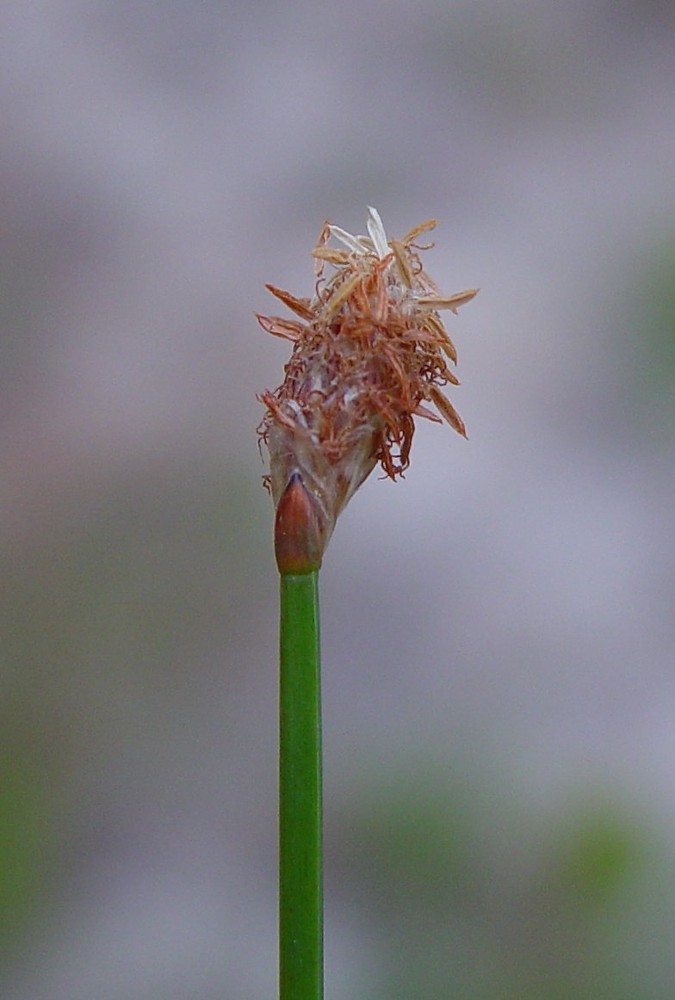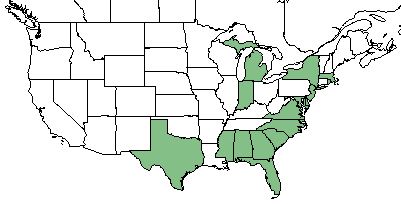Difference between revisions of "Eleocharis melanocarpa"
(→Description) |
|||
| Line 33: | Line 33: | ||
==Ecology== | ==Ecology== | ||
===Habitat=== <!--Natural communities, human disturbed habitats, topography, hydrology, soils, light, fire regime requirements for removal of competition, etc.--> | ===Habitat=== <!--Natural communities, human disturbed habitats, topography, hydrology, soils, light, fire regime requirements for removal of competition, etc.--> | ||
| − | ''E. melanocarpa'' is a facultative wetland species found in moist to wet ditches and freshwater pond margins.<ref name="Ward & Leigh 1975">Contributions to the flora of Florida: 8, ''Eleocharis'' (Cyperaceae). Castanea 40(1):16-36.</ref> | + | ''E. melanocarpa'' is a facultative wetland species found in moist to wet ditches and freshwater pond margins.<ref name="Ward & Leigh 1975">Contributions to the flora of Florida: 8, ''Eleocharis'' (Cyperaceae). Castanea 40(1):16-36.</ref> Such occurrences in these habitats are often ephemeral, sandy, and can range from sunny to shady.<ref name="Reid & Faulkner 2010">Reid C. S. and Faulkner P. L. (2010). Louisiana. Castanea 75(1):138-140.</ref> |
| Line 39: | Line 39: | ||
<!--===Seed dispersal===--> | <!--===Seed dispersal===--> | ||
<!--===Seed bank and germination===--> | <!--===Seed bank and germination===--> | ||
| − | + | ===Fire ecology=== <!--Fire tolerance, fire dependence, adaptive fire responses--> | |
| + | Despite typically inhabiting wet areas, fires from adjacent habitats (e.g. long-leaf pine savannas, sand-hill pines, Oldfield, etc.) are thought to burn into drawn-down areas of wet ponds/ditches. Such burns likely maintain more open canopy conditions benefiting populations of ''E. melanocarpa.'' <ref name="Reid & Faulkner 2010"/> | ||
| + | |||
<!--===Pollination===--> | <!--===Pollination===--> | ||
<!--===Use by animals===--> <!--Herbivory, granivory, insect hosting, etc.--> | <!--===Use by animals===--> <!--Herbivory, granivory, insect hosting, etc.--> | ||
Revision as of 19:05, 4 December 2017
| Eleocharis melanocarpa | |
|---|---|

| |
| Photo by © Arthur Haines, New England Wild Flower Society | |
| Scientific classification | |
| Kingdom: | Plantae |
| Division: | Magnoliophyta - Flowering plants |
| Class: | Liliopsida - Moncots |
| Order: | Poales |
| Family: | Cyperaceae |
| Genus: | Eleocharis |
| Species: | E. melanocarpa |
| Binomial name | |
| Eleocharis melanocarpa Torr. | |

| |
| Natural range of Eleocharis melanocarpa from USDA NRCS Plants Database. | |
Common names: Black-fruited spikerush, blackfruit spikerush[1][2]
Contents
Taxonomic Notes
Description
On its seed, the tubercle is very short and dilated with its projecting edge rolled over and surrounding the top of the nut.[3] The tips of the culms of E. melanocarpa often arch over and root in the substrate forming a dense tangle. [4] It commonly grows in stools containing several roots and five to 20 stems. Stems range in length from 1 to 3.6 ft (0.3 to 1.1 m) in length. Stools are commonly bunched together into clusters 1 ft (0.3 m) or more in diameter.[3]
Distribution
E. melanocarpa ranges from Massachusetts to Florida and Mississippi, disjunct to eastern Texas, southern Michigan, and northern Indiana. [2][4][1]
Ecology
Habitat
E. melanocarpa is a facultative wetland species found in moist to wet ditches and freshwater pond margins.[5] Such occurrences in these habitats are often ephemeral, sandy, and can range from sunny to shady.[6]
Fire ecology
Despite typically inhabiting wet areas, fires from adjacent habitats (e.g. long-leaf pine savannas, sand-hill pines, Oldfield, etc.) are thought to burn into drawn-down areas of wet ponds/ditches. Such burns likely maintain more open canopy conditions benefiting populations of E. melanocarpa. [6]
Conservation and Management
Cultivation and restoration
Photo Gallery
References and notes
- ↑ 1.0 1.1 Weakley A. S.(2015). Flora of the Southern and Mid-Atlantic States. Chapel Hill, NC: University of North Carolina Herbarium.
- ↑ 2.0 2.1 USDA, NRCS. (2016). The PLANTS Database (http://plants.usda.gov, 30 November 2017). National Plant Data Team, Greensboro, NC 27401-4901 USA.
- ↑ 3.0 3.1 Hill E. J. (1894). Eleocharis melanocarpa a proliferous plant. Bulletin of the Torrey Botanical Club. 25(7):392-394.
- ↑ 4.0 4.1 Sorrie B. A. and Leonard S. W. (1999). Noteworthy records of Mississippi vascular plants. Sida 18:889-908.
- ↑ Contributions to the flora of Florida: 8, Eleocharis (Cyperaceae). Castanea 40(1):16-36.
- ↑ 6.0 6.1 Reid C. S. and Faulkner P. L. (2010). Louisiana. Castanea 75(1):138-140.